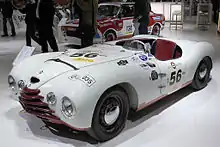Škoda Sport
The Škoda Sport was a sports racing car, designed, developed, and produced by Czechoslovak automobile manufacturer Škoda. The two-seater roadster with aluminum body and pontoon construction was released in 1949.[1]

Design
The car is based on the Škoda 1101 Tudor, introduced in 1946. The body was made by hand from aluminum sheets. The water-cooled, top-controlled four- cylinder - four- stroke - in-line engine with one or two compressors had a displacement of 1089 or 1221 cm³ and an output of 37-66 kW (50-90 hp) in suction mode and 48-132 kW (65-180 hp) in compressor operation. It accelerated the 655-715 kg vehicle up to 140-180 km/h (in suction mode). Via the gearbox flanged to the engine block and a Cardan shaft, with the driving force being transmitted to the rear wheels. The car's skeleton frame, which was forked at the front and rear, consisted of welded steel U-profiles and had a central tube.[2]
At the 24 Hours of Le Mans in 1950, drivers Václav Bobek and Jaroslav Netušil were initially able to keep up well. The usual racing fuel at the time was a mixture of petrol, ethanol, and acetone. The Škoda Sport thus reached a top speed of 140 km/h and achieved an average speed of 126 km/h. In the 13th hour, however, the car had to give up due to a defect.[3]
Škoda Supersport
In 1950 the Škoda Supersport appeared in parallel. This vehicle was designed as a monoposto with free-standing wheels and also had an aluminum body. In addition to the engines mentioned above, a unit with a displacement of 1490 cm³ was used. The engine and driving performance also corresponded to the aforementioned model.[4]
The bodies of both types were refurbished several times and fitted with different engines.
References
- "Skoda Sport (1949): Ein Tscheche in Le Mans". Motor1.com.
- "ŠKODA Sport (1949): The long-distance runner from the other side of the Iron Curtain". ŠKODA Storyboard.
- "Škoda 1100 Sport - typ 966, 1949 [Auta5P ID:23392 EN]". auta5p.eu.
- Drăgan, Otilia (June 30, 2021). "1949 Skoda Sport Redefined Racing Stamina Before a Baffling Ending at Le Mans". autoevolution.